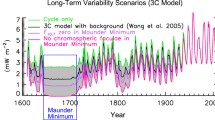Abstract
Global electron content (GEC) as a new ionospheric parameter was first proposed by Afraimovich et al. [2006]. GEC is equal to the total number of electrons in the near-Earth space. GEC better than local parameters reflects the global response to a change in solar activity. It has been indicated that, during solar cycle 23, the GEC dynamics followed similar variations in the solar UV irradiance and F 10.7 index, including the 11-year cycle and 27-day variations. The dynamics of the regional electron content (REC) has been considered for three belts: the equatorial belt and two midlatitude belts in the Northern and Southern hemispheres (±30° and 30°–65° geomagnetic latitudes, respectively). In contrast to GEC, the annual REC component is clearly defined for the northern and southern midlatitude belts; the REC amplitude is comparable with the amplitude of the seasonal variations in the Northern Hemisphere and exceeds this amplitude in the Southern Hemisphere by a factor of ∼1.7. The dayside to nightside REC ratio, R(t), at the equator is a factor of 1.5 as low as such a GEC ratio, which indicates that the degree of nighttime ionization is higher, especially during the solar activity maximum. The pronounced annual cycle with the maximal R(t) value near 8.0 for the winter Southern Hemisphere and summer Northern Hemisphere is typical of midlatitudes.
Similar content being viewed by others
References
E. L. Afraimovich, E. I. Astafyeva, and I. V. Zhivetiev, “Solar Activity and Global Electron Content,” Dokl. Akad. Nauk 409(3), 399–402 (2006a) [Dokl. Akad. Nauk 409A (6), 921–924 (2006a)].
E. L. Afraimovich, E. I. Astafyeva, A. V. Oinats, et al., “Global Electron Content as a New Index of Solar Activity. Comparison with IRI Modeling Results,” IRI News 13(1A5) (2006b).
S.-I. Akasofu and S. Chapman, Solar-Terrestrial Physics (Pergamon, Oxford, 1972; Mir, Moscow, 1975).
W. J. G. Beynon and G. M. Brown, “Region E and Solar Activity,” J. Atmos. Phys. 15, 168–174 (1959).
D. Bilitza, “International Reference Ionosphere,” Radio Sci. 36(2), 261–275 (2001).
B. E. Bryunelli and A. A. Namgaladze, Physics of the Ionosphere (Nauka, Moscow, 1988) [in Russian].
Handbook of Radio Electronics Theory, Ed. by B. Kh. Krivitskii (Energiya, Moscow, 1977), Vol. 2 [in Russian].
B. Hofmann-Wellenhof, H. Lichtenegger, and J. Collins, Global Positioning System: Theory and Practice (Springer, New York, 1992).
G. S. Ivanov-Kholodny and G. M. Nikol’skii, The Sun and the Ionosphere (Nauka, Moscow, 1969) [in Russian].
N. Jakowski, S. Heise, A. Wehrenpfennig, et al., “GPS/GLONASS-Based TEC Measurements as a Contributor for Space Weather,” J. Atmos. Sol.-Terr. Phys. 64(5–6), 729–735 (2002).
N. Jakowski, B. Fichtelmann, and A. Jungstand, “Solar Activity Control of Ionosphere and Thermosphere Processes,” J. Atmos. Terr. Phys. 53, 1125–1130 (1991).
D. L. Judge, D. R. McMullin, H. S. Ogawa, et al., “First Solar EUV Irradiances Obtained from SOHO by the Celias/Sem,” Sol. Phys. 177, 161–173 (1998).
I. A. Krinberg and A. V. Tashchilin, The Ionosphere and Plasmasphere (Nauka, Moscow, 1984) [in Russian].
R. Leitinger, M. Zhang, and S. M. Radicella, “An Improved Bottom Side for the Ionosphere Electron Density Model NeQuick,” Ann. Geophys. 48(3), 525–534 (2005).
L. Liu, W. Wan, B. Ning, et al., “Solar Activity Variations of the Ionosphere Peak Electron Density,” J. Geophys. Res., 111, A08304 (2006).
A. J. Mannucci, B. D. Wilson, D. N. Yuan, et al., “A Global Mapping Technique for GPS-Derived Ionosphere TEC Measurements,” Radio Sci. 33(3), 565–582 (1998).
A. V. Mordvinov and L. A. Plyusnina, “Coherent Structures in the Dynamics of the Large-Scale Solar Magnetic Field,” Astron. Zh. 78(8), 753–760 (2001) [Astron. Rep. 45 (8), 652–658 (2001)].
A. V. Mordvinov and R. C. Willson, “Effect of Large-Scale Magnetic Fields on Total Solar Irradiance,” Sol. Phys. 215, 5–16 (2003).
A. A. Nusinov and V. V. Katyushina, “Lyman-Alpha Line Intensity as a Solar Activity Index in the Far Ultraviolet Range,” Sol. Phys. 152, 201–206 (1994).
A. A. Nusinov, “The Ionosphere as a Natural Detector for Studying Long-Period Variations in the Fluxes of Solar Geoeffective Radiation,” Geomagn. Aeron. 44(6), 779–786 (2004) [Geomagn. Aeron. 44, 718–725 (2004)].
K.-I. Oyama, K. Noguchi, M. Izawa, et al., “Local Time, Annual, Latitude, and Seasonal Variations of Total Electron Content over Japan,” ISAS Res. Note 796 (2005).
S. Schaer, G. Beutler, and M. Rothacher, “Mapping and Predicting the Ionosphere,” in Proceedings of the IGS AC Workshop, Darmstadt, 1998, pp. 307–320.
C. Torrence and G. P. Compo, “A Practical Guide to Wavelet Analysis,” Bull. Am. Meteorol. Soc. 79, 61–78 (1998).
I. S. Veselovsky, et al., “Solar and Heliospheric Phenomena in October–November 2003: Causes and Consequences,” Kosm. Issled. 42(5), 453–508 (2004).
Yu. I. Vitinsky, M. Kopetsky, and G. V. Kuklin, Statistics of Sunspot Formation Activity (Nauka, Moscow, 1986) [in Russian].
Author information
Authors and Affiliations
Additional information
Original Russian Text © E.L. Afraimovich, E.I. Astafyeva, I.V. Zhivetiev, A.V. Oinats, Yu.V. Yasyukevich, 2008, published in Geomagnetizm i Aeronomiya, 2008, Vol. 48, No. 2, pp. 195–208.
Rights and permissions
About this article
Cite this article
Afraimovich, E.L., Astafyeva, E.I., Zhivetiev, I.V. et al. Global electron content during solar cycle 23. Geomagn. Aeron. 48, 187–200 (2008). https://doi.org/10.1134/S0016793208020084
Received:
Accepted:
Published:
Issue Date:
DOI: https://doi.org/10.1134/S0016793208020084




